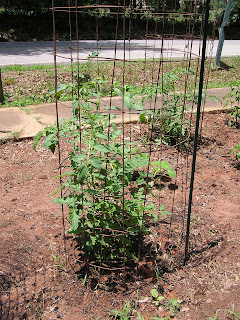Real tomatoes need real support. Those little 3-4' slightly conical cages that are still the staple sold at garden centers? - Not gonna do it. Those adorable swirly garden sculptures that claim to support your cosseted red deliciousness? They are adorable, aren't they. Not gonna do it. Maybe for dwarf tomatoes, maybe for that "patio" variety, but if you're growing a real 'mater, get yourself a real cage. Think this through - on any given good day in July, your prized tomato plant may have anywhere between 6 and 30 maturing fruits. Roughly 3 medium-sized ones weigh a pound, so you might have anywhere between 2 and 15 pounds of anticipation on that vine. Then bring along a Georgia July thunderstorm. You just don't want to risk it.
My best recommendation: if you're going to grow your own, make your own. Use something called WWM, which some folks refer to as Woven Wire Mesh or Welded Wire Mesh. Some may even call it woven welded wire mesh but WWWM starts to invoke some sort of wrestling match. WWM is used as reinforcement in building sidewalks or other concrete structures; it's laid into the concrete form as the concrete is being poured. It will be available at Lowe's or HD in rolls and you'll have to cut it into sections to form each cage. One roll might cost in the range of $50, but will make 8 or 10 cages - so go in with a friend or sell the extra to cover costs. They will last for years!
When choosing your WWM, consider the width (or height in your case). 5 feet is great, 6 is better. Also consider the size of the mesh - 6" squares are pretty good. 4" is kinda small - imagine sticking your hand in, grabbing onto a luscious half-pound tomato, and then trying to get it and your fist back through the mesh. If you've got a 4" mesh you might get stuck there like a raccoon in a trap. I mean - who could risk letting go of a half-pound tomato lest it fall onto the ground to it's demise?! I would have to stand there until a rescue operation became available.
Once you have your roll of mesh, unroll it, cutting it into lengths of about 5-6.5 feet. 5 feet will get you a cage of roughly 18" diameter, 6.5 feet will be more like 24" diameter. When you cut the mesh, cut just before a vertical wire, leaving the lengths of horizontal wire free. This way when you wrap it into a circle, you can use these free lengths to fold back over the other side of the mesh in order to secure it into a circle. Hmmm... maybe next year I'll make some more and do a tutorial with photos... that would probably be nice huh. It's all rather self-explanatory once you start doing it though.
After your cages are put together, very carefully place them over your plants, making sure not to break or bruise branches. And then - stake your cage. A 24" wooden property stake can work; I use a 5' steel fence post. Hammer the stake into the ground directly adjacent to your cage **make sure you're not hammering into any underground utilities! Call Before You Dig if you have any question! You can call 811 or 1-800-282-7411 for them to come mark or flag your utility lines. Click here for more information. The stake should sink into the ground at least 8" if you've got hard ground and 12" or more if your ground is soft. Then tie your cage to the stake on at least 2 places. You can use twine, string, old hosiery, or fabric as ties.
As your tomato plants grow, inspect them regularly and gently re-insert any branches that poke through the caging. Leaves poking through are fine, but if a branch gets out and grows to become a high-producer, it will weigh the branch down onto the cage, bruising and even breaking it.
In the next post we'll discuss the benefits of staking or caging on other types of vegetable crops.
Tuesday, June 1, 2010
Subscribe to:
Post Comments (Atom)




No comments:
Post a Comment